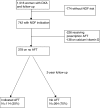Correlates of use of antifracture therapy in older women with low bone mineral density
- PMID: 16808749
- PMCID: PMC1924624
- DOI: 10.1111/j.1525-1497.2006.00468.x
Correlates of use of antifracture therapy in older women with low bone mineral density
Abstract
Background: Guidelines exist for treatment of low bone mineral density (BMD). Little is known about patient characteristics associated with use of treatment.
Objectives: To determine patient-related correlates of medication use following screening dual x-ray absorptiometry (DXA) of older adults.
Design: Secondary analysis of a prospective cohort study.
Setting: Pittsburgh, PA and Memphis, TN.
Participants: Community-dwelling women between the ages 70 and 79 years enrolled in the Health, Aging, and Body Composition (Health ABC) Study.
Measurements: Risk factors for fracture and BMD of the hip were assessed at baseline. Patients and their community physicians were supplied the results of the DXA scan. Prescription and over-the-counter medication use was collected at annual exams for 2 years.
Results: Of 1,584 women enrolled in Health ABC, 378 had an indication for antifracture therapy and were not receiving such treatment at baseline. By the second annual follow-up examination, prescription antiresorptive medication was reported in 49 (13.0%), whereas 65 (17.2%) received calcium and/or vitamin D supplementation. In adjusted models, the strongest predictor for use of any antifracture medicine was presence of osteoporosis [vs osteopenia, odds ratio (OR), 2.9 (1.7 to 4.7)], white race [OR, 2.6 (1.5 to 4.8)], and receipt of the flu shot [OR, 2.2 (1.3 to 3.8)]. Neither a history of falls nor prior fracture was associated with use of antifracture medications.
Conclusion: Even when physicians of study participants were provided with DXA scan results, 70% of older high-functioning women with an indication for therapy did not start or remain on an antifracture therapy. Substantial room for improvement exists in fracture prevention following a diagnosis of low BMD-especially among women with a history of falls, prior fractures, and among black women.
Figures

Similar articles
-
Utilization of DXA Bone Mineral Densitometry in Ontario: An Evidence-Based Analysis.Ont Health Technol Assess Ser. 2006;6(20):1-180. Epub 2006 Nov 1. Ont Health Technol Assess Ser. 2006. PMID: 23074491 Free PMC article.
-
Which is the preferred site for bone mineral density monitoring as an indicator of treatment-related anti-fracture effect in routine clinical practice? A registry-based cohort study.Osteoporos Int. 2019 Jul;30(7):1445-1453. doi: 10.1007/s00198-019-04975-y. Epub 2019 Apr 23. Osteoporos Int. 2019. PMID: 31016351
-
Summary of AHRQ's comparative effectiveness review of treatment to prevent fractures in men and women with low bone density or osteoporosis: update of the 2007 report.J Manag Care Pharm. 2012 May;18(4 Suppl B):S1-15; discussion S13. doi: 10.18553/jmcp.2012.18.s4-b.1. J Manag Care Pharm. 2012. PMID: 22716221 Free PMC article.
-
Osteoporosis: trials and tribulations.Am J Med. 1997 Aug 18;103(2A):74S-87S; discussion 87S-89S. doi: 10.1016/s0002-9343(97)90029-2. Am J Med. 1997. PMID: 9302899 Review.
-
The treatment of osteoporosis. Antiresorptive therapy.Clin Lab Med. 2000 Sep;20(3):603-22, viii. Clin Lab Med. 2000. PMID: 10986624 Review.
Cited by
-
Patterns of anti-osteoporosis medication use among women at high risk of fracture: findings from the Global Longitudinal Study of Osteoporosis in Women (GLOW).PLoS One. 2013 Dec 20;8(12):e82840. doi: 10.1371/journal.pone.0082840. eCollection 2013. PLoS One. 2013. PMID: 24376589 Free PMC article.
-
Undertreatment of osteoporosis and the role of gastrointestinal events among elderly osteoporotic women with Medicare Part D drug coverage.Clin Interv Aging. 2015 Nov 5;10:1813-24. doi: 10.2147/CIA.S83488. eCollection 2015. Clin Interv Aging. 2015. PMID: 26604724 Free PMC article.
-
Predictors of treatment with osteoporosis medications after recent fragility fractures in a multinational cohort of postmenopausal women.J Am Geriatr Soc. 2012 Mar;60(3):455-61. doi: 10.1111/j.1532-5415.2011.03854.x. Epub 2012 Feb 8. J Am Geriatr Soc. 2012. PMID: 22316070 Free PMC article.
-
Association of gastrointestinal events and osteoporosis treatment initiation in newly diagnosed osteoporotic Israeli women.Int J Clin Pract. 2015 Sep;69(9):1007-14. doi: 10.1111/ijcp.12676. Epub 2015 Aug 17. Int J Clin Pract. 2015. PMID: 26278464 Free PMC article.
-
Predictors of oral bisphosphonate prescriptions in post-menopausal women with osteoporosis in a real-world setting in the USA.Osteoporos Int. 2010 Aug;21(8):1427-36. doi: 10.1007/s00198-009-1079-7. Epub 2009 Oct 2. Osteoporos Int. 2010. PMID: 19798459 Free PMC article.
References
-
- Looker AC, Johnston CC, Jr, Wahner HW, et al. Prevalence of low femoral bone density in older US women from NHANES III. J Bone Miner Res. 1995;10:796–802. - PubMed
-
- Kanis JA, Johnell O, Oden A, Dawson A, De Laet C, Jonsson B. Ten year probabilities of osteoporotic fractures according to BMD and diagnostic thresholds. Osteoporos Int. 2001;12:989–95. - PubMed
-
- Black DM, Thompson DE, Bauer DC, et al. Fracture risk reduction with alendronate in women with osteoporosis: the Fracture Intervention Trial. FIT Research Group. J Clin Endocrinol Metab. 2000;85:4118–24. - PubMed
-
- Cummings SR, Black DM, Thompson DE, et al. Effect of alendronate on risk of fracture in women with low bone density but without vertebral fractures: results from the Fracture Intervention Trial. JAMA. 1998;280:2077–82. - PubMed
-
- Watts NB, Josse RG, Hamdy RC, et al. Risedronate prevents new vertebral fractures in postmenopausal women at high risk. J Clin Endocrinol Metab. 2003;88:542–9. - PubMed
Publication types
MeSH terms
Substances
Grants and funding
LinkOut - more resources
Full Text Sources
Medical
